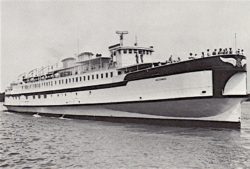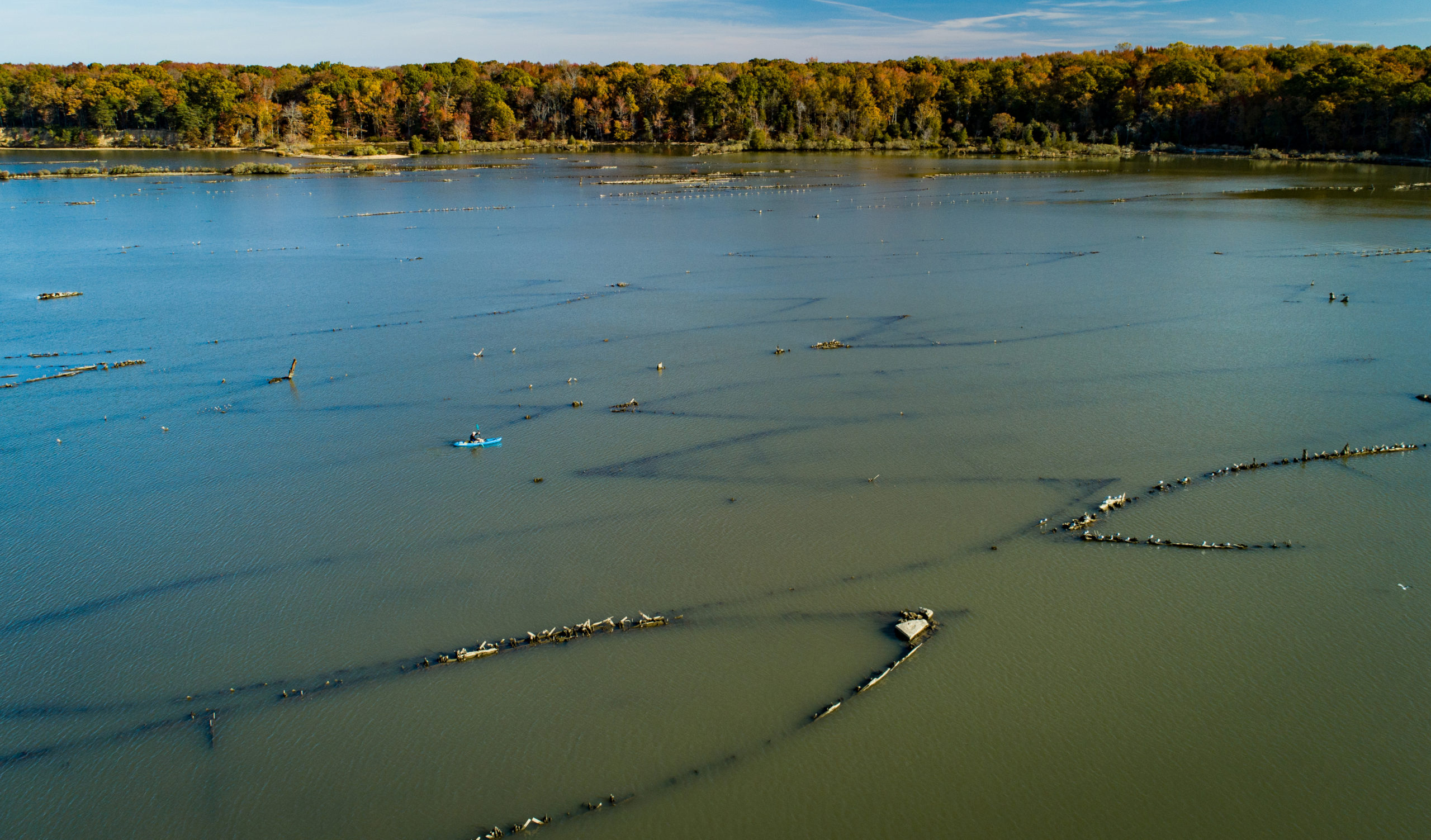
8 Sights to See in Mallows Bay-Potomac River National Marine Sanctuary
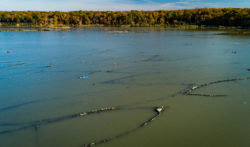
Shipwrecks of Mallows Bay-Potomac River National Marine Sanctuary. (Photo: Matt McIntosh/NOAA)
Designated in September of 2019 – the first new site in the National Marine Sanctuary System in nearly 19 years – Mallows-Bay Potomac River National Marine Sanctuary in Southern Maryland protects nearly 200 shipwrecks known as the “Ghost Fleet” and fosters populations of wildlife connected to the Chesapeake Bay watershed. The National Trust for Historic Preservation also names Mallows Bay a National Treasure for its protection of the largest, most diverse single collection of historic shipwrecks in the Western Hemisphere as well as historic artifacts and cultural histories of three tribal nations, commercial fishing, America’s military, and others. The resources safeguarded by the sanctuary date back as far as the Revolutionary and Civil Wars, and nearly 100 of the shipwrecks within the site are wooden steamships built for use in World War I.
Just because the site is protected doesn’t mean it’s closed off, however. Kayaking, wildlife viewing, and hiking are just some of the recreational activities available to the public in and near Mallows Bay-Potomac River National Marine Sanctuary. There is a lot to love about Mallows Bay and the Ghost Fleet, and just as much to see and experience if you get the opportunity to visit. Here are some sights within the sanctuary we think are worth seeing:
For history buffs:
Within the boundaries of Mallows Bay-Potomac River National Marine Sanctuary are hundreds of shipwrecks, nearly half of which are World War I era steam ships built for the U.S. Emergency Fleet between 1917 and 1919. This collection of 100 ships is the largest set of homogenous wrecks in the world, with the remaining half in the area representing ships and history of various periods in U.S. history. Some of these ships are visible from shore, some are visible from the water, and some only reveal themselves during lower tides.
Click here to learn more about the area and see a suggested self-guided paddle shipwreck tour route. Here are four wrecks you’ll find along the way:
S.S. Accomac, one of the newest shipwreck additions to Mallows Bay. The Accomac is the only steeled hulled vessel in the Mallows-Bay wide water area and is the most modern ship design in the area made entirely off steel. It served as a car ferry connecting Norfolk to Virginia’s Eastern Shore prior to the construction of the Chesapeake Bay Bridge Tunnel in 1964. She ran until she suffered a fire and was taken out of commission. The Accomac was dumped in Mallows Bay in 1973. It is the most distinct and visible vessel at the site and is roughly the same size as the ships in the ghost fleet. This wreck is located in the Potomac River, to the east of the mouth of Burning Basin.
Benzonia: A 1919 WWI Steamship built in Washington state. For a short period, the Benzonia was engaged in the war effort but was sold to Western Marine and Salvage Company in 1922. In 2003, Hurricane Isabel lifted the Benzonia wreck on top of another WWI steamship, the Caribou. In 2013, a mysterious fire caught in her stern section. Benzonia is located just north of Accomac.
S.S. Boone: This wood and steel ship was named by the wife of President Woodrow Wilson and launched in August of 1918 in the presence of 3,000 spectators. Unfortunately, Boone’s career, like many other vessels built hastily for WWI was brief, and she, like hundreds of others, was sold for scrap in 1922, to end her days in Mallows Bay. The Boone is Northeast of the Benzonia and is closer to the shore.
Yahwah: Yawah was a merchant vessel. She is documented as making at least one European voyage, to Genoa, Italy, in late 1919. Laid up in the James River during the Great Ship Tie-up of 1920, she was eventually purchased at auction by the Western Marine and Salvage Company for scrapping and moved to the Potomac River soon afterwards. Yawah is entirely submerged except at low tide. This wreck is north of the Accomac.
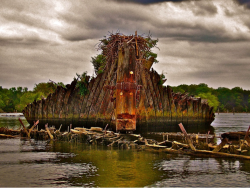
The Benzonia in Mallows-Bay Potomac River National Marine Sanctuary (Photo Credit: Don Shomette)
For wildlife enthusiasts:
Animal lovers rejoice! Mallows Bay-Potomac River and the ecosystems that formed around the collection of shipwrecks provide habitat for some of the Chesapeake Bay watershed’s coolest and ecologically important species of birds and other wildlife. There are opportunities to see these animals from land or in the water – but don’t forget your Ocean Etiquette! Here are some of our favorites:
Ospreys: One of North America’s largest birds of prey and one of the most widespread birds on the earth. Ospreys can grow up to 2 feet in length with a wingspan of up to 6 feet. Nearly a quarter of all ospreys in the contiguous U.S. nest in the Chesapeake Bay region. They search for food by hovering over the water briefly before diving feet first to grab a fish.
Bald Eagle: An American icon and a fierce predator. For many decades, bald eagles were hunted for sport and for the “protection” of fishing grounds. Pesticides like DDT also wreaked havoc on eagles and other birds but since DDT was banned, populations have recovered. These majestic birds can have a wingspan of 8 feet and can divebomb at speeds of nearly 100 miles an hour to catch fish. They can usually be found nesting in the trees along the shoreline or gliding high in the air, surveying the land and water for prey.
Great Blue Heron: These beautiful blue-gray birds are amusing to watch as they often stand motionless or move very sneakily as they scan the water for prey. It lives year-round in marshes and wetlands throughout the Chesapeake Bay region. The great blue heron flies with slow, deep wingbeats, holding its neck in a graceful S-shape. They are often found in shallow waters near the shore, on rocks, or nesting in the trees.
Red Bellied Cooter also known as the red belly turtle. It is an aquatic turtle with a dark shell and – you guessed it! – a red belly. You can often find them sunbathing near the water’s edge, either on land or rocks above the water’s surface. These turtles are extremely shy and easily startled. If you spot a red-bellied cooter in the wild, it’s best to keep your distance and use binoculars or your phone’s camera to get a better look. If you get too close, it will quickly swim away.
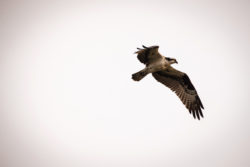
Flying osprey at Mallow Bay-Potomac River National Marine Sanctuary. (Photo credit: Matt McIntosh/NOAA)

